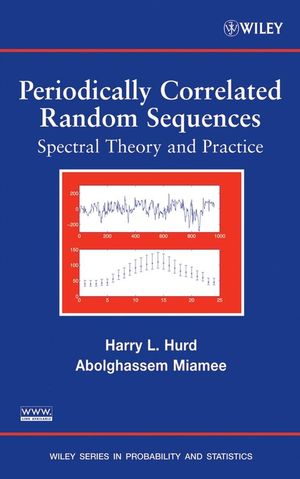Periodically Correlated Random Sequences: Spectral Theory and PracticeISBN: 978-0-471-34771-2
Hardcover
384 pages
October 2007
 This is a Print-on-Demand title. It will be printed specifically to fill your order. Please allow an additional 15-20 days delivery time. The book is not returnable.
|
||||||
Acknowledgments.
Glossary.
1. Introduction.
1.1 Summary.
1.2 Historical Notes.
Problems.
2. Examples, Models and Simulations.
2.1 Examples and Models.
2.1.1 Random Periodic Sequences.
2.1.2 Sums of Periodic and Stationary Sequences.
2.1.3 Products of Scalar Periodic and Stationary Sequences.
2.1.4 Time Scale Modulation of Stationary Sequences.
2.1.5 Pulse Amplitude Modulation.
2.1.6 A More General Example.
2.1.7 Periodic Autoregressive Models.
2.1.8 Periodic Moving Average Models.
2.1.9 Periodically Perturbed Dynamical Systems.
2.2 Simulations.
2.2.1 Sums of Periodic and Stationary Sequences.
2.2.2 Products of Scalar Periodic and Stationary Sequences.
2.2.3 Time Scale Modulation of Stationary Sequences.
2.2.4 Pulse Amplitude Modulation.
2.2.5 Periodically Perturbed Logistic Maps.
2.2.6 Periodic Autoregressive Models.
2.2.7 Periodic Moving Average Models.
Problems.
3. Review of Hilbert Spaces.
3.1 Vector Spaces.
3.2 Inner Product Spaces.
3.3 Hilbert Spaces.
3.4 Operators.
3.5 Projection Operators.
3.6 Spectral Theory of Unitary Operators.
3.6.1 Spectral Measures.
3.6.2 Spectral Integrals.
3.6.3 Spectral Theorems.
Problems.
4. Stationary Random Sequences.
4.1 Univariate Spectral Theory.
4.1.1 Unitary Shift.
4.1.2 Spectral Representation.
4.1.3 Mean Ergodic Theorem.
4.1.4 Spectral Domain.
4.2 Univariate Prediction Theory.
4.2.1 Infinite Past, Regularity and Singularity.
4.2.2 Wold Decomposition.
4.2.3 Innovation Subspaces.
4.2.4 Spectral Theory and Prediction.
4.2.5 Finite Past Prediction.
4.3 Multivariate Spectral Theory.
4.3.1 Unitary Shift.
4.3.2 Spectral Representation.
4.3.3 Mean Ergodic Theorem.
4.3.4 Spectral Domain.
4.4 Multivariate Prediction Theory.
4.4.1 Infinite Past, Regularity and Singularity.
4.4.2 Wold Decomposition.
4.4.3 Innovations and Rank.
4.4.4 Regular Processes.
4.4.5 Infinite Past Prediction.
4.4.6 Spectral Theory and Rank.
4.4.7 Spectral Theory and Prediction.
4.4.8 Finite Past Prediction.
Problems.
5. Harmonizable Sequences.
5.1 Vector Measure Integration.
5.2 Harmonizable Sequences.
5.3 Limit of Ergodic Average.
5.4 Linear Time Invariant Filters.
Problems.
6. Fourier Theory of the Covariance.
6.1 Fourier Series Representation of the Covariance.
6.2 Harmonizability of R(s; t).
6.2.1 Harmonizability of Xt.
6.4 Covariance and Spectra for Specific Cases.
6.4.1 PC White Noise.
6.4.2 Products of Scalar Periodic and Stationary Sequences.
6.5 Asymptotic Stationarity.
6.6 Lebesgue Decomposition of F.
6.7 The spectrum of mt.
6.8 Effects of Common Operations on PC Sequences.
6.8.1 Linear Time Invariant Filtering.
6.8.2 Differencing.
6.8.3 Random Shifts.
6.8.4 Sampling.
6.8.5 Bandshifting.
6.8.6 Periodically Time Varying (PTV) Filters.
Problems.
7. Representations of PC Sequences.
7.1 The Unitary Operator of a PC Sequence.
7.2 Representations Based on the Unitary Operator.
7.2.1 Gladyshev Representation.
7.2.2 Another Representation of Gladyshev Type.
7.2.3 Time-dependent Spectral Representation.
7.2.4 Harmonizability Again.
7.2.5 Representation Based on Principal Components.
7.3 Mean Ergodic Theorem.
7.4 PC Sequences as Projections of Stationary Sequences.
Problems.
8. Prediction of PC Sequences.
8.1 Wold Decomposition.
8.2 Innovations.
8.3 Periodic Autoregressions of Order 1.
8.4 Spectral Density of Regular PC Sequences.
8.4.1 Spectral Densities for PAR(1).
8.5 Least Mean Square Prediction.
8.5.1 Prediction Based on Infinite Past.
8.5.2 Prediction for a PAR(1) Sequence.
8.5.3 Finite Past Prediction.
Problems.
9. Estimation of Mean and Covariance.
9.1 Estimation of mt : Theory.
9.2 Estimation of mt : Practice.
Problems.
10. Spectral Estimation.
10.1 The Shifted Periodogram.
10.2 Consistent Estimators.
10.3 Asymptotic Normality.
10.4 Spectral Coherence 363.
10.4.1 Spectral Coherence for Known T.
10.4.2 Spectral Coherence for Unknown T.
10.5 Spectral Estimation : Practice.
10.5.1 Confidence Intervals.
10.5.2 Examples.
10.6 Effects of Discrete Spectral Components.
10.6.1 Removal of the Periodic Mean.
10.6.2 Testing for Additive Discrete Spectral Components.
10.6.3 Removal of Detected Components.
Problems.
11. A Paradigm for Nonparametric Analysis of PC Time Series.
11.1 The Period T is Known.
11.2 The Period T is Unknown.
References.
Index.



